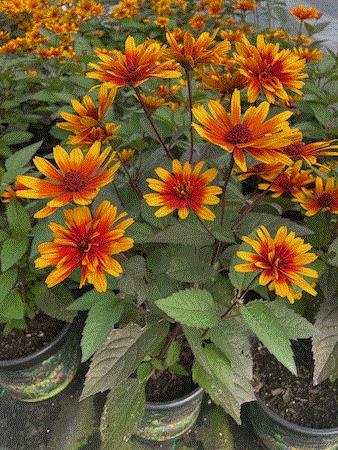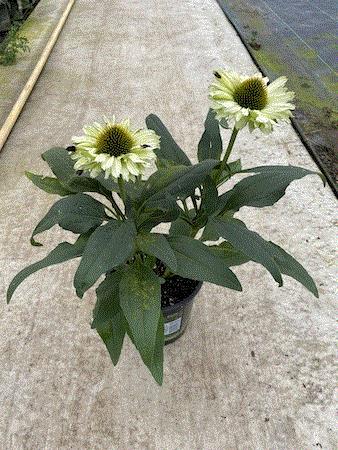What’s Happening Here?
It’s time for another diagnostic challenge. Are you ready? In this week’s challenge I wanted to show you something that was unusual to me and hopefully for you, too. Having said that, I think almost everyone should be able to solve the challenge. Here it is, take a look:
I observed something peculiar on these echinacea leaves. Do you know what’s happening here? I’m guessing you already have the answer, but hold onto that thought for a few and enjoy the content below. I’ll reveal the answer
before signing off.
Heliopsis Funky Spinner

Here’s a great new heliopsis I’ve fallen in love with. Funky Spinner has dark foliage that’s almost black when grown in full sun (the leaves appear lighter when grown inside a greenhouse, as shown here). Besides its dark leaves, I love the two-toned flowers—bright golden petals with an orange-red base.
It branches freely, creating lots of flower power. I’ve even trimmed some of them back and they fully reflowered. It grows 2- to 3-ft. tall and makes a great backdrop in the landscape. We get our starting materials as tissue culture from
Green Trade Horticulture. Don’t hold me to it, but I believe they're hardy to Zone 5.
Did you miss these?
Did you miss the two awesome webinars my colleagues at GrowerTalks hosted last month? No worries, you can catch the replays.
Perennials for Cut Flowers
Perennials are an important part of the crop mix on a diversified cut flower farm. Many perennials bloom weeks before summer annuals, giving you an early start on the season with additional income opportunities.
In this GrowerTalks webinar, brought to you by Ball Seed, you’ll hear about perennial cut flowers from a range of the world’s best breeding and producing companies, including Benary, GET Group, Green Leaf Plants, Darwin Perennials and Walters Gardens. Best of all, it’s timed perfectly to bring in new varieties as we head into the late summer/fall planting season.
Click
HERE to watch the pre-recorded Perennials for Cut Flowers Webinar.
Time for the Notorious O-O-MY-CETES
The oomycetes (Oomycota), also known as water molds, are a group of pathogens that play a large role in the decomposition of plants and the breakdown of organic matter. While this scenario is perfect for the great outdoors, it can cost greenhouse growers millions of dollars in yearly sales.
In this webinar, Dr. Emma Lookabaugh, Technical Specialist for BASF, will discuss how to look for symptoms of downy mildew, Phytophthora and Pythium along with prevention and control measures to keep these notorious oomycetes from ruining your crops.
Sponsored by BASF.
Click
HERE to watch the O-O-MY-CETES webinar.

The Floral Industry is Well-Positioned
Here’s part of a great article from the Society of American Florist (SAF) I thought I’d share. It’s written by the managing editor of SAF NOW Amanda Jedlinsky.
On the heels of two extraordinary years that brought double digit profits—as well as unprecedented challenges—a growing, fortified floral industry is well positioned to weather the headwinds of inflation and keep flowers top of mind for consumers.
That was the message that Kate Penn, CEO of the Society of American Florists, delivered during the State of the Industry address at SAF Orlando 2022, the 137th annual convention in Orlando, Florida.
SAF CEO Kate Penn recapped how the floral industry has grown during the State of the Industry address at the association’s 137th annual convention in Orlando.
“This two-year growth period has created an urgency about how we keep these flower-buying customers,” Kate said.
The floral industry is growing. From the number of imports to sales of U.S.-grown crops and spending on floral products, the floral industry has grown and even hit records. Kate provided these statistics from a variety of sources, including the U.S. Department of Commerce, the USDA and the Bureau of Economic Analysis:
-
Average sales at retail flower shops are about $679,000. That average is expected to grow by 5% in 2023 and 2% for the next few years.
-
Total spending on floral products from 2020 to 2021 grew 21.5% to $46.6 billion dollars.
-
Sales of U.S.-grown floriculture crops grew 16% from 2019 to 2021, hitting the $6 billion mark for the first time.
-
More than a third of that is in annual bedding plants, followed by perennial plants and potted flowering plants, with about $1 billion in sales each. Cut flowers comprise $360 million in sales and cut greens are $105 million.
-
There’s been an 8% increase in the number of growers, and that number doesn’t include the increase in flower and plant growers doing less than $100,000 in annual sales, which Kate said is significant.
-
Imports to the U.S. also increased. Year to date, there has been a 28% increase in dollar volume and a 15% increase in product volume of imported cut flowers, totaling $1.19 billion.
GO HERE to read the rest of the article.

New Online Pest IdentificationTool
The Horticultural Research Institute (HRI), the research arm of AmericanHort, in partnership with the National Plant Board and the USDA, announced the launch of a new web-based tool for nursery and greenhouse growers seeking to improve plant production processes by identifying areas where plants could be contaminated or introduced to plant pests.
The 2014 Farm Bill included funding specifically for what was then a brand new program designed to help plant producers minimize risks at the beginning of production to avoid headaches at the end. Called Systems Approach to Nursery Certification (SANC), it’s a voluntary, grower-driven, state-verified plant health certification partnership that applies quality management principles to the entire plant production process. SANC was developed as a holistic approach to growing and certifying plants that satisfies applicable state and federal plant health regulations.
To ensure that plants moving in the horticultural trade are free of regulated invasive pests that threaten agriculture and the environment, greenhouses and nurseries are regulated by state and federal authorities. SANC applies best practices at key points in the plant production process to address identified risks. These practices are integrated into a growing operation system, hence “systems approach” in the name.
McKay Nursery (Wisconsin), Star Roses and Plants (Pennsylvania), and Dickman Farms (New York) were some of the first growing operations to ship plants under the SANC certification. During the last few years, more growers and nurseries have adopted the program for their production.
To make the process easier, HRI, the National Plant Board and USDA developed a new web-based risk assessment tool. Although it was designed to help growers more easily perform the risk assessment required to participate in SANC, the tool is available, at no cost, to any nursery or greenhouse seeking to improve their processes, whether they choose to pursue SANC certification or not.
Growers may request free user access to begin a facility risk assessment by visiting the Risk Assessment website at hriresearch-sanc.org. You can also learn more about this new tool in a free webinar on September 26, 2022 at 3:00 p.m. Eastern hosted by Craig Regelbrugge, AmericanHort’s executive vice president of advocacy, research and industry relations.
You can register for the webinar
HERE.

The Answer is …

At the top of the newsletter, I showed the image above and asked if you knew what was going on with the echinacea leaves. I think you can see what I’m asking about. If not, focus your attention to the center of the image—the leaf in the middle of the image and the one that's front and center. Depending on your device and screen size, it may be hard to see, so here’s a closer view:
Is that really algae growing on the leaves? If that’s your answer, too, you correctly solved this week's challenge.
You might be asking yourself, “Why is there algae growing on the plant?” or “Are these being grown in a tropical area?” Well, they were grown in the Midwest, which definitely isn’t considered tropical, but this particular group of echinacea were receiving lots of overhead irrigation and it was a fairly warm to hot summer there this year.
I should avoid using the word tropical when discussing this, as algae can grow and thrive under the same conditions we grow our plants at. Essentially, algae can prosper anywhere there's moisture, light and nutrients.
In situations such as what occurred with the echinacea, the occurrence or progression of the algae can be lessened by reducing the time the leaves remain wet. This can be done with dehumidification (where possible), increasing the airflow around the plants (crop spacing and/or horizontal air flow fans) and by watering at a time of the day when the leaves would dry out quickly (late morning sprinklers versus watering before sunrise). It’s too late for this crop, but drip irrigation, such as using drip tape or subirrigation are options that will keep the foliage dry.
The growth of algae on plants can be lessened or prevented when applying various products. Copper-based fungicides or bactericides, disinfectants such as Zerotol or Kleengrow, and certain fungicides (Daconil, Mural) have been shown to be effective at controlling algae on plants. Be sure to read the product labels for rates and application methods.




Thanks for reading this edition of Perennial Pulse. My email is paul@opelgrowers.com if you have any comments, article suggestions or if you'd just like to say hello.
Paul Pilon
Editor-at-Large—Perennial Pulse
Director of Growing—Opel Growers
This email was received by you and 34,709 other fine subscribers!
If you're interested in advertising in Perennial Pulse, contact Kim Brown ASAP and she'll hook you up.